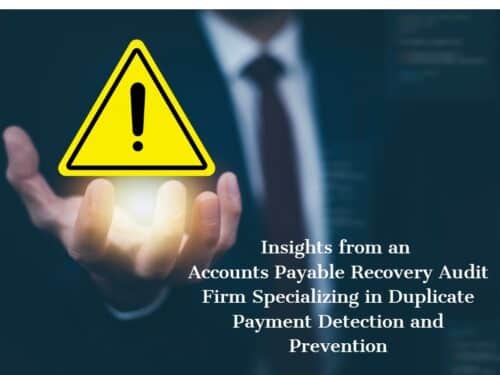
Introduction
In the intricate landscape of Accounts Payable, one of the most insidious threats lurking in the shadows is that of duplicate payments. These seemingly innocent errors can have far-reaching consequences, draining financial resources and undermining the efficiency of organizational processes. As a leading Accounts Payable Recovery Audit firm specializing in duplicate payment detection and prevention, we have witnessed firsthand the havoc that duplicate payments can wreak on businesses of all sizes. In this article, we will delve into the realm of duplicate payment prevention, exploring the strategies and best practices that can help organizations mitigate this risk and safeguard their financial health.
Understanding Duplicate Payments
Duplicate payments occur when a vendor invoice is paid more than once, either intentionally or inadvertently. Common causes of duplicate payments include data entry errors, vendor master file issues, internal control “work arounds,” unknown ERP issues, fraudulent activities and human error. The impact of duplicate payments extends beyond mere monetary losses, tarnishing the reputation of businesses and eroding trust with vendors. From small enterprises to multinational corporations, no organization is immune to the threat posed by duplicate payments.
The Role of Accounts Payable Audit
Accounts Payable Audits play a pivotal role in identifying and rectifying duplicate payments. By meticulously examining financial records, invoices, and payment transactions, auditors can uncover discrepancies and irregularities that may indicate the presence of duplicate payments. Through a combination of manual review and data analysis, auditors can pinpoint the root causes of duplicate payments and recommend corrective actions to prevent recurrence.
Best Practices for Duplicate Payment Prevention
Preventing duplicate payments requires a multifaceted approach encompassing people, processes, and technology. Implementing robust internal controls and segregation of duties can help mitigate the risk of duplicate payments arising from human error or fraudulent activities. Establishing clear approval workflows and documentation procedures can streamline the invoice approval process and reduce the likelihood of duplicate payments slipping through the cracks. Additionally, a well-maintained vendor master file is critical to duplicate payment prevention. Moreover, leveraging automation and software solutions, including duplicate payment prevention tools in addition to controls in the ERP, can enhance the efficiency and accuracy of Accounts Payable processes, minimizing the risk of duplicate payments.
Case Study Example
Consider the case of a mid-sized manufacturing company that was hemorrhaging millions of dollars due to duplicate payments. Through a comprehensive Accounts Payable audit conducted by our firm, it was discovered that the “dirty” vendor master data was the root cause of the problem. By implementing a vendor master data clean-up project and establishing guidelines, processes and internal controls, the company was able to eliminate the vast majority of duplicate payments and realize substantial cost savings.
Tips for Implementing Duplicate Payment Prevention Measures
For organizations seeking to fortify their duplicate payment prevention efforts, here are some practical tips to consider:
- Conduct regular Accounts Payable audits to proactively identify and address duplicate payments.
- Invest in training and continuous education for Accounts Payable staff to enhance their awareness of the risks associated with duplicate payments.
- Leverage technology solutions such as automated invoice matching and payment validation to streamline Accounts Payable processes and minimize the risk of duplicate payments.
- Consider the addition of duplicate payment prevention software.
Conclusion
In conclusion, duplicate payment prevention is a critical imperative for organizations looking to safeguard their financial integrity and operational efficiency. By adopting a proactive approach to Accounts Payable management and implementing robust internal controls, businesses can mitigate the risk of duplicate payments and ensure the accuracy and reliability of their financial transactions. As an Accounts Payable audit firm specializing in duplicate payment detection and prevention, we are committed to helping organizations navigate the complex terrain of duplicate payment prevention and emerge stronger and more resilient in the face of adversity.
Strategic Audit Solutions, Inc. is a leading Accounts Payable Recovery Audit firm specializing in duplicate payment detection and prevention. With a team of experienced auditors and innovative technology solutions, including DupeShield®, we help organizations across all industries identify and mitigate the risk of duplicate payments, safeguarding their financial health and operational efficiency. For inquiries or assistance with duplicate payment prevention, please contact us.
SAS Insights

The SaaS Revolution- Your Recovery Audit Secret Weapon
The SaaS Revolution: Your Recovery Audit Secret Weapon Let’s be honest, cloud migration isn’t exactly breaking news. But you know what is? The explosive growth of SaaS adoption. Reports1 indicate […]
Continue Reading
AP Recovery Audits- The Essential Guide to Protecting Your Bottom Line
AP Recovery Audits- The Essential Guide to Protecting Your Bottom Line Organizations process millions of transactions annually. Amid this volume, errors are inevitable. Whether it’s duplicate payments, missed credits, or […]
Continue Reading
The Importance of Maintaining a Clean Vendor Master File
The Importance of Maintaining a Clean Vendor Master File The vendor master file is a cornerstone of accounts payable operations and plays a crucial role in maintaining financial integrity and […]
Continue Reading
Mastering Duplicate Payment Prevention
Introduction In the intricate landscape of Accounts Payable, one of the most insidious threats lurking in the shadows is that of duplicate payments. These seemingly innocent errors can have far-reaching […]
Continue Reading
